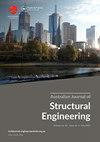Effect of fly ash cement and polypropylene fibre on the performance of recycled aggregate concrete column under thermal loading: Experimental and numerical study
IF 1.3
Q4 ENGINEERING, CIVIL
Australian Journal of Structural Engineering
Pub Date : 2021-01-02
DOI:10.1080/13287982.2021.1872994
引用次数: 2
Abstract
ABSTRACT The utilization of industrial waste as a partial replacement in construction materials has been increasing rapidly in recent years. This Paper investigates the performance of reinforced concrete columns comprising of recycled aggregates, fly ash and synthetic fibres in varying percentage, under monotonic and thermal loads. Ten full scale reinforced concrete columns of size 150 x 150 x 750 mm were experimentally studied under compressive loads. Results of the experiment showed that the polypropylene (PP) fibre reinforced fly ash column with recycled aggregate consisting of 1.5% PP fibre, 15% fly ash and 25% recycled aggregates exhibited better load carrying and deflection capacities and was further considered for numerical analysis. The conventional column was modelled as a control specimen and the behaviour of polypropylene fibre-reinforced fly ash column with recycled aggregate was comparatively studied under the action of thermal loads in ABAQUS. In order to understand the effect of fibre-reinforced polymer (FRP) rebar reinforcement in columns under thermal loads, a parametric study was carried out by varying the type of reinforcement, using carbon fibre-reinforced polymer rebar (CFRP) and glass fibre-reinforced polymer rebar (GFRP). The polypropylene fibre-reinforced fly ash column with recycled aggregate reinforced with CFRP rebars exhibited better performance under thermal loads.粉煤灰水泥和聚丙烯纤维对热载荷下再生骨料混凝土柱性能的影响:试验与数值研究
近年来,工业废物作为建筑材料的部分替代品的利用率迅速增加。本文研究了由不同比例的再生骨料、粉煤灰和合成纤维组成的钢筋混凝土柱在单调和热负荷下的性能。试验研究了10根尺寸为150 × 150 × 750mm的钢筋混凝土柱在压缩荷载作用下的受力情况。试验结果表明,聚丙烯纤维掺量为1.5%、粉煤灰掺量为15%、再生骨料掺量为25%的聚丙烯纤维增强粉煤灰柱具有较好的承载和挠曲能力,可进一步进行数值分析。以常规柱为对照试件,在ABAQUS软件中比较研究了含再生骨料聚丙烯纤维增强粉煤灰柱在热载荷作用下的性能。为了了解纤维增强聚合物(FRP)钢筋在热载荷作用下对柱的加固效果,采用碳纤维增强聚合物钢筋(CFRP)和玻璃纤维增强聚合物钢筋(GFRP)进行了不同加固类型的参数化研究。再生骨料加CFRP筋的聚丙烯纤维增强粉煤灰柱在热载荷作用下表现出较好的性能。
本文章由计算机程序翻译,如有差异,请以英文原文为准。
求助全文
约1分钟内获得全文
求助全文
来源期刊

Australian Journal of Structural Engineering
ENGINEERING, CIVIL-
CiteScore
2.50
自引率
0.00%
发文量
31
期刊介绍:
The Australian Journal of Structural Engineering (AJSE) is published under the auspices of the Structural College Board of Engineers Australia. It fulfils part of the Board''s mission for Continuing Professional Development. The journal also offers a means for exchange and interaction of scientific and professional issues and technical developments. The journal is open to members and non-members of Engineers Australia. Original papers on research and development (Technical Papers) and professional matters and achievements (Professional Papers) in all areas relevant to the science, art and practice of structural engineering are considered for possible publication. All papers and technical notes are peer-reviewed. The fundamental criterion for acceptance for publication is the intellectual and professional value of the contribution. Occasionally, papers previously published in essentially the same form elsewhere may be considered for publication. In this case acknowledgement to prior publication must be included in a footnote on page one of the manuscript. These papers are peer-reviewed as new submissions. The length of acceptable contributions typically should not exceed 4,000 to 5,000 word equivalents. Longer manuscripts may be considered at the discretion of the Editor. Technical Notes typically should not exceed about 1,000 word equivalents. Discussions on a Paper or Note published in the AJSE are welcomed. Discussions must address significant matters related to the content of a Paper or Technical Note and may include supplementary and critical comments and questions regarding content.
 求助内容:
求助内容: 应助结果提醒方式:
应助结果提醒方式:


